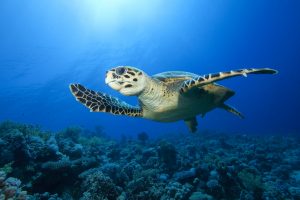Getting to know the sea turtles of St John

First time visitors to St John as well as “loyalists” almost all want to spend time with the sea turtles during their time on St John. That’s good news: The more people that enjoy these wonderful ancient creatures the more interest there will be in protecting them. Despite the impressive sizes of the clutches the females lay only one in a thousand is destined to survive. Predators during the hatchlings initial scramble for the waters are certainly a factor but humans are now their biggest threat. Plastic bags, balloons (mistaken for jellyfish) as well as fishing nets are all culprits. Let’s do all we can to save these beautiful creatures.
Three sea turtles inhabit our waters: the Green Turtle the Leatherback and the Hawskbill:
 Green Turtle
Green Turtle

Hawksbill Turtle

Leatherback Turtle
Sea Turtle hatchlings:
The hatchling’s gender depends on the sand temperature. Lighter sands maintain higher temperatures, which decreases incubation time and results in more female hatchlings. Incubation takes about two to three months. The eggs in one nest hatch together over a very short period of time. When ready, hatchlings tear their shells apart with their snout and dig through the sand, again, usually at night. Once they reach the surface, they instinctively head towards the sea by orienting towards the brightest direction and use the topography of the surrounding horizon line. They have to dodge a number of predators, such as seabirds, mammals and crabs. The hatchlings then proceed into the ocean, where a variety of marine predators await them. Sadly, only an estimated one in 1000 will survive to adulthood. These natural threats, however, are not the reasons sea turtle populations have plummeted toward extinction.
Where to see sea turtles on St john:
You usually see Green Turtles in those places with sea grass beds (like Maho, Francis and Salt Pond Bay) and Hawksbill around reefs (e.g. Scott and Turtle Bay). The Leatherback turtles are the largest species of sea turtle, weighing on average 600-800 pounds but are unfortunately almost extinct and can rarely be seen. For ore information please see: https://www.calabashcottages.com/national-park-st-john-leatherback-sea-turtle/
For information about protecting sea turtles please read this excellent article from the Virgin Island national Park: https://www.nps.gov/viis/learn/nature/turtles-of-the-virgin-islands.htm or

